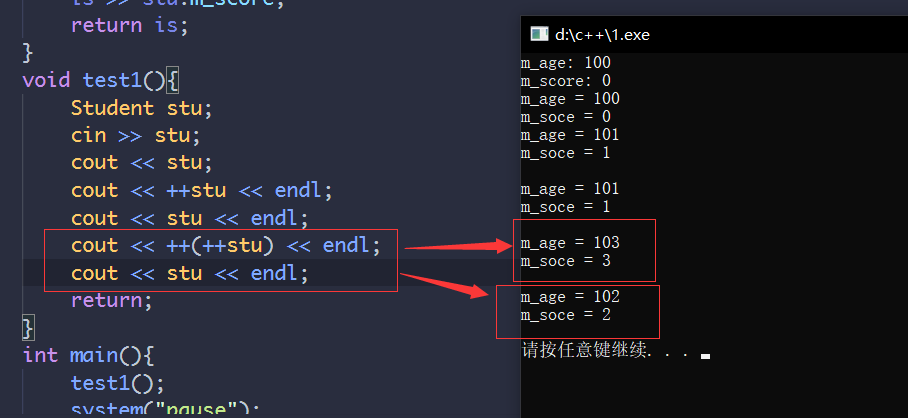C++中一共有两种自增运算符
1、前置自增运算符
2、后置自增运算符
前置自增运算符可以链式使用,而后置自增运算符不可以链式使用
1、重载前置运算符
by 成员函数的方式
#include <iostream>using namespace std;class Student{public:int m_age;double m_score;Student(){m_age = 19;m_score = 100.0;}Student(const Student& stu){m_age = stu.m_age;m_score = stu.m_score;}Student& operator++(){ // 这里一定要是返回对象的引用 否则链式使用的时候会出问题(this->m_age)++;(this->m_score)++;return *this;}};ostream& operator<<(ostream& os,const Student& stu){os << "m_age = " << stu.m_age << endl;os << "m_soce = " << stu.m_score << endl;return os;}istream& operator>>(istream& is,Student& stu){cout << "m_age: ";is >> stu.m_age;cout << "m_score: ";is >> stu.m_score;return is;}void test1(){Student stu;cin >> stu;cout << stu;cout << ++stu << endl;cout << ++(++stu) << endl; // 可以像这个样子链式使用前置自增return;}int main(){test1();system("pause");return 0;}

虽然链式使用了两次自增运算符,但是实际上数据只自增了一次。
原因: 第二次自增的时候,系统重新构造出了一个数据相同的对象。因此,重载前置运算符的时候的返回值一定是对象的引用。
2、重载后置运算符
by 成员函数
#include <iostream>using namespace std;class Student{public:int m_age;double m_score;Student(){m_age = 19;m_score = 100.0;}Student(const Student& stu){m_age = stu.m_age;m_score = stu.m_score;}Student& operator++(){(this->m_age)++;(this->m_score)++;return *this;}Student operator++(int){Student tempStudent(*this);m_age ++;m_score ++;return tempStudent;}};ostream& operator<<(ostream& os,const Student& stu){ //重载左移运算符os << "m_age = " << stu.m_age << endl;os << "m_soce = " << stu.m_score << endl;return os;}istream& operator>>(istream& is,Student& stu){ // 重载右移运算符cout << "m_age: ";is >> stu.m_age;cout << "m_score: ";is >> stu.m_score;return is;}void test1(){//Student stu = *(new Student()); 该方法可以将数据开辟到堆区Student stu; // 默认构造函数创建对象cout << stu << endl;cout << (stu++) << endl;//cout << (stu++)++ << endl; // 是不允许这样的操作的。cout << stu << endl;return;}int main(){test1();system("pause");return 0;}

